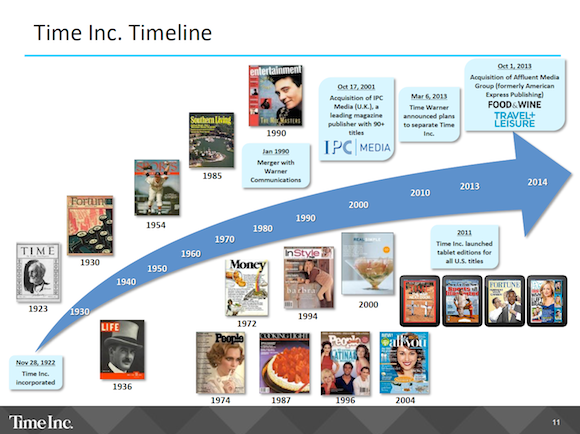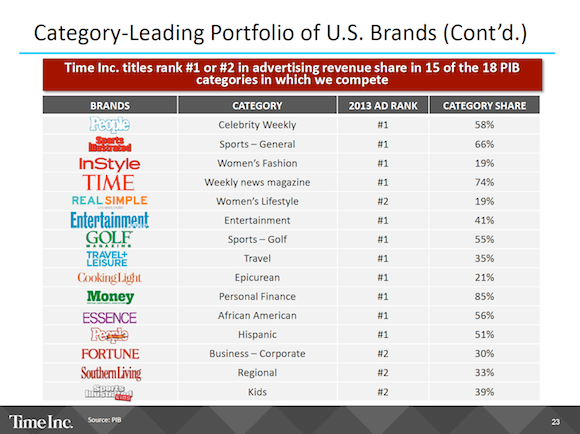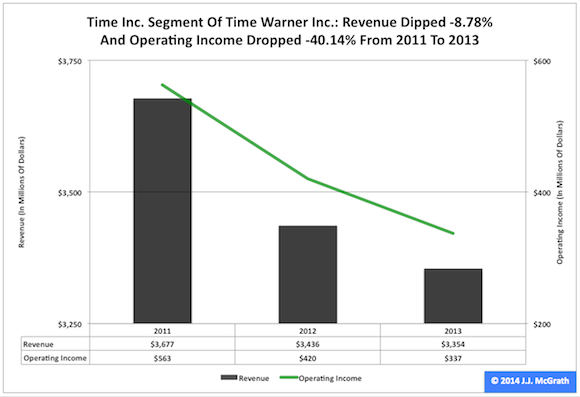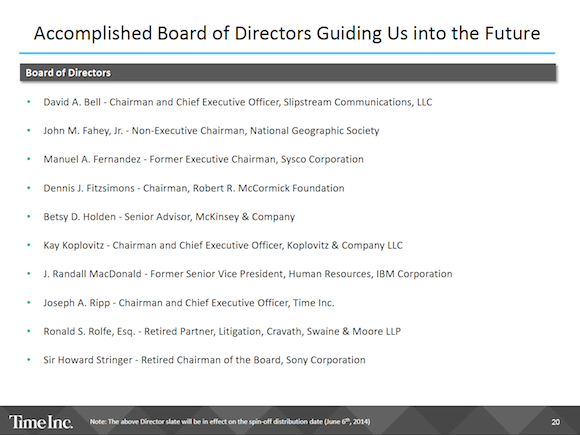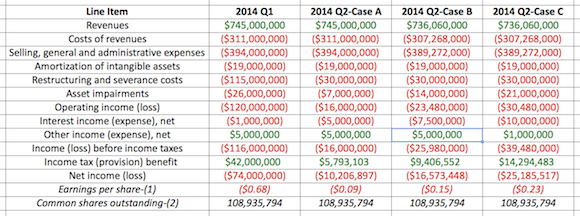Equity-market participants with an interest in Time Inc. (TIME) in
the wake of its recent spinoff by Time Warner Inc. (TWX) would be wise to take a time-out
to review the company’s financial data in depth. On the one hand, Time Inc. ranks
as the No. 1 magazine publisher in the U.S. by print-advertising revenue and
readership with titles such as People,
Time and Sports Illustrated. On the other hand, its revenue dipped -8.78
percent from 2011 to 2013, while its operating income dropped -40.14 percent on
the same basis.
The only constant at the megamagazine-publishing concern
co-founded by the innovative Briton Hadden and Henry R. Luce more than 90 years
ago, change was on the march at Time Inc. again this week as the
company’s equity traded under its new ticker symbol for the first time since being
divested by Time Warner.
Time Warner effected the spinoff by distributing all
outstanding shares of Time Inc. common stock to the erstwhile parent company’s
shareholders at a ratio of one share of Time Inc. common stock for every eight
shares of Time Warner common stock held on May 23, as noted in a U.S.
Securities and Exchange Commission Form
8-K filed by the former parent firm on Monday. These shares numbered 108,935,794,
as pointed out in an SEC Form
8-K filed by Time Inc. on June 5.
Based on TIME’s closing share price of $22.55, I calculated
Time Inc.’s market capitalization as about $2.46 billion on Thursday.
Headquartered in New York and listed on the New York Stock
Exchange, Time Inc.’s share count is likely to swell over time for a number of
reasons, one being the 12.50 million shares earmarked for the company’s 2014
Omnibus Incentive Compensation Plan mentioned in the SEC Form
S-8 Registration Statement filed by the firm on Wednesday.
Time Inc.’s stock changed hands under the ticker TIME.WI
between May 21 and June 6, and under the ticker TIME from Monday to Thursday.
During these 16 trading days, its closing share price was in the range of
$20.85-$23.48, with a median of $22.13, a mean of $22.24 and a standard
deviation of 86 cents, based on figures at Yahoo Finance.
Time Inc.’s price was comparatively nonvolatile over this
period, but its volume was emphatically otherwise. The number of shares traded
on a daily basis ranged from a low of 94,000 to a high of 20,066,600, with a
median of 1,226,050, a mean of 3,689,275 and a standard deviation of 5,624,364.
These numbers indicate a whole lot of shakin’ goin’ on among
Time Inc.’s institutional investors, which own about 86.64 percent of the
company, according to Nasdaq.com.
Figure 1: A Brief
History Of Time (Inc.)
Source: Time Inc. Analyst Presentation, May 14.
Co-founders Hadden and Luce likely would be happy about some
developments and unhappy about other developments at Time Inc. since their
respective heydays at the company carrying the name of their weekly
newsmagazine into the 21st century (Figure 1). The former died at 31 in 1929,
while the latter died at 68 in 1967.
As the managing editor of the weekly Editor & Publisher magazine in 2000, I was stunned by how well
Time Inc. and its corporate parent did in allowing the creation of the monthly Real Simple magazine, which was beautifully
executed both in content and form. I believe Hadden and Luce would be happy
about many things concerning Real Simple.
As a contributor to Seeking
Alpha in 2014, I am equally stunned by how poorly Time Inc. and its
corporate parent have done in managing the online presence of Fortune, the business magazine whose print
product has been repurposed on Time Warner’s CNNMoney site for years. One
person’s brand mismanagement is another person’s corporate synergy.
In measuring the popularity of online sites, the Alexa unit
of Amazon.com Inc. (AMZN) on
Thursday assigned a global rank of No. 158 to Forbes.com, No. 853 to Businessweek.com
and No. 31,382 to Fortune.com, the latter of which recently made its debut. I
think Hadden and Luce would be unhappy about the delay in launching Fortune.com.
Figure 2: Time Inc. A
Good House In A Bad Neighborhood?
Source: Time Inc.
Analyst Presentation, May 14.
Time Inc. counts among its holdings more than 90 magazines and
over 45 online sites in three countries: Mexico, the U.K. and the U.S. Among
the 23 print titles published in the U.S. are many able competitors for
advertising-revenue share in their respective categories, as indicated by data
gathered by the Publishers Information Bureau (Figure 2).
However, Neal Lulofs, executive vice president of the
Alliance for Audited Media (the nonprofit organization formerly known as the
Audit Bureau of Circulations), recapitulated in a blog
post on Feb. 6 the following key figures associated with AAM’s semiannual “Snapshot”
report on U.S. consumer magazines for the second half of 2013:
“Total average circulation for the 386 U.S. consumer magazines reporting comparable paid and verified circulation was down 1.7 percent, with paid subscriptions down 1.2 percent and single-copy sales down 11.1 percent. Digital editions continue to be a growing segment for consumer magazines. More than 300 titles reported a total of 10.8 million digital replica editions (paid, verified and analyzed nonpaid) or 3.5 percent of total circulation. Digital editions are up 36.7 percent versus the same period last year when 289 magazines reported more than 7.9 million digital replica editions, or 2.4 percent of the total industry average circulation.”
Twenty-five years after Tim Berners-Lee authored the
proposal leading to the establishment of the World Wide Web, Time Inc. and its
competitors in the magazine industry clearly continue to have great deal of work to
do in adapting their business models to a world where new balances between
online and print presences are being struck every day.
In this challenging environment, Time
Inc. announced on June 2 its acquisition of Cozi Inc., a privately held, Seattle-based
technology company with an assortment of family-organizing tools accessible via
a variety of digital devices, not only smartphones but also desktop, laptop and
tablet personal computers.
Figure 3: Revenue
Hasn’t Been Revving Up At Time Inc.
Source: This J.J.’s
Risky Business chart is based on data in
the SEC Form 10-K filed by Time Warner Inc. on Feb. 26.
In the Time
Warner announcement of the completion of the spinoff of Time Inc. on
Monday, company Chairman and CEO Jeffrey L. Bewkes said:
“The spinoff of Time Inc. completes the process we began several years ago to position Time Warner as the world’s leading video content company. Our strategy reflects our commitment to delivering strong returns to our shareholders as we light up the world with the best storytelling. The spinoff gives Time Warner even more focus as we continue to deliver on this strategy.”
The announcement made no reference to the spinoff giving
Time Warner a chance to divest a business unit whose revenue and operating
income have been falling for years (Figure 3). Despite this deterioration, Time
Inc. did contribute about 11.26 percent of its former parent company’s top line
of $29.80 billion in 2013.
Figure 4: Time Inc.’s
Board Of Directors As Of Monday
Source: Time Inc.
Analyst Presentation, May 14.
Time Inc. is led by Joseph A. Ripp, chairman and CEO;
Jeffrey J. Bairstow, executive vice president and chief financial officer; and
Norman Pearlstine, executive vice president and chief content officer. Ripp discussed
a few of the many challenges awaiting his magazine-centered company in an
interview with Lucia Moses, senior editor at Digiday,
where it was published in a question-and-answer format on Tuesday.
With the abovementioned example of Fortune.com in mind, I
was pleased to read the following remark made by Ripp during the interview:
“We’ve really been focused on the cultural part of Time Inc. because I understood that was the biggest impediment to our success. There was not a Time Inc.-centered management.”
Of course, Time Inc. faces other challenges, some based in
reality and some based in perception.
One reality-based challenge facing Time Inc. centers on the
company’s balance sheet, which encompasses at least $1.4 billion in long-term
debt, as detailed by Time Warner in an SEC Form
424B5 filed on May 21. The breakdown of this debt is as follows:
• $700 million in a senior secured credit facility providing
for a loan with a seven-year maturity. It is guaranteed by substantially all of
Time Inc.’s wholly owned domestic subsidiaries.
• $700 million in 5.75 percent senior unsecured notes due
2022. They are guaranteed by substantially all of Time Inc.’s wholly owned
domestic subsidiaries.
Time Inc. assumed almost all this debt to make a couple of
huge payments to its former parent Time Warner: one for the distribution of a
special dividend of precisely $589,858,212.54 and the other for the purchase of
U.K.-based IPC Media for imprecisely $810,141,787.46. Neither Time Inc. nor
Time Warner has disclosed the actual purchase price, apparently, with both pegging it at about $800 million.
It appears Time Inc. also has the option to add another $500
million in long-term debt through a senior secured credit facility providing
for a loan with a five-year maturity as long as the company does it between now
and June 30. It would be guaranteed by substantially all of the firm’s wholly
owned domestic subsidiaries.
Meanwhile, Time Inc. anticipated it would have about $136
million in cash and cash equivalents upon the completion of its spinoff.
One perception-based challenge facing Time Inc. centers on
the company’s board of directors (Figure 4). If its members were chosen in part
for the purpose of reassuring stakeholders about the future prospects of a
major media firm with substantial print holdings, falling revenue and rising
debt, then Dennis J. FitzSimons appears an odd pick. I would not describe as
happy his tenure as the chairman and CEO of the old publicly traded Tribune Co.
(TRB), as opposed to the new publicly traded Tribune Co. (TRBAA).
Figure 5: Time Inc. Income In 2014, Actual (Q1) And Projected (Q2)
Notes: (1) All estimated
EPS figures in this table are based on 108,935,794 common shares outstanding.
(2) The number of common shares outstanding represents those distributed by
Time Warner when it completed the spinoff of Time Inc.
Source: This J.J.’s
Risky Business table is based on analyses
of data in the SEC Form 10-Q filed by Time Inc. on May 14, among other company documents.
I began my examination of Time Inc. with the goal of
determining a reasonable TIME valuation range I could either employ in my own operations or publish here. Because of all the assumptions I had to make
in adhering to each valuation methodology, however, the best I can say now is I believe the equity is priced in the range between fairly valued and
overvalued versus the range between undervalued and fairly valued.
I anticipate Time Inc.’s financial report for the second
quarter may allow me to use the company’s data in place of most or all of my
assumptions.
Amid all the assuming this and assuming that, I developed
estimates for Time Inc.’s Q1 and Q2 income statements that capture what I
believe I know, what I think I know and what I know I know about the company’s actual
and projected financial performance in the first half of this year (Figure 5).
Assumption No. 1 led me to look at the financials of Time
Inc. as if it had been a stand-alone company since New Year’s Day, even though
it has been a Time Warner unit most of this year.
With respect to 2014 Q1, I deployed a mixture of actual and
projected figures to estimate Time Inc. had a loss per share of -68 cents. My
key assumption was the company had 108,935,794 common shares outstanding during
the period, but, of course, it was a Time Warner unit with no common shares
outstanding at that time.
With respect to 2014 Q2, I employed projected numbers to
estimate Time Inc. may report a loss per share ranging between -9 and -23
cents. Based on data in the SEC Form 10-Q filed by the company on May 14 and
other documentation, these projected numbers were used to develop estimates in
three cases, as follows:
• Case A, which I consider optimistically rational.
• Case B, which I consider unemotionally rational.
• Case C, which I consider pessimistically rational.
If Time Inc. reports for Q2 a loss per share near to my
estimated range, then I will feel pretty good about other assumptions I have
made about the company’s operations. If the firm reports for Q2 either earnings
or a loss per share far from my estimated range, then I will be heading back to
the old drawing board.
Many risks associated with Time Inc. as either an investment
or a trading vehicle are described in Time Warner’s latest SEC Form 10-K. Among
them is the company’s declining revenue in the areas of advertising and subscription,
which in 2013 respectively provided it with 53.88 percent and 33.66 percent of
its revenue as a Time Warner unit. Other risks encompass those related to the significant
goodwill and substantial long-term debt on the Time Inc. balance sheet, as well
as those mentioned in Exhibit 99.1 of the SEC Form
10-12B/A the firm filed on April 28.
A few risks associated with anything as either an investment
or a trading vehicle include changes in the monetary policies of the U.S.
Federal Reserve and other central banks around the world. Along this line, it
is important to note the Federal
Open Market Committee will conduct its next meeting on June 17-18, when it
may choose to continue tapering its current quantitative-easing program.
Disclaimer: The opinions
expressed herein by the author do not constitute an investment recommendation,
and they are unsuitable for employment in the making of investment decisions.
The opinions expressed herein address only certain aspects of potential
investment in the securities of any companies mentioned and cannot substitute
for comprehensive investment analysis. The opinions expressed herein are based
on an incomplete set of information, illustrative in nature, and limited in
scope, and there are limitations to their accuracy. The author recommends all
investors conduct detailed investment research of their own, including review
of relevant SEC filings and consultation with a qualified investment adviser.
The information upon which this article is based was obtained from sources
believed to be reliable, but it has not been independently verified, which
means the author cannot guarantee the accuracy of this information. In
addition, the opinions expressed herein reflect the author’s best judgment as
of the date of publication, and they are subject to change without notice.
